Motorcycle Engine Types with Configuration & Layouts
Indian two-wheeler market which has the majority of audience belonging to the middle-class category remained focused to offer budget offering until a decade ago. It made automakers to spawn out motorcycles majorly with small capacity single-cylinder engines. However, the emergence of prominent names in the biking industry like Kawasaki, Triumph, BMW and Suzuki, not only helped in the expansion of market but also made possible the availability of performance-oriented motorcycles with multiple cylinders. These motorcycles feature different category of engines from parallel twins to massive flat albeit their configuration and layouts are sophisticated meant for motorheads only. Still, the explanation of engines here would help you to understand different types of engines with their merits and demerits and more. Let’s start with the most affordable single-cylinder engine.
Single-cylinder:
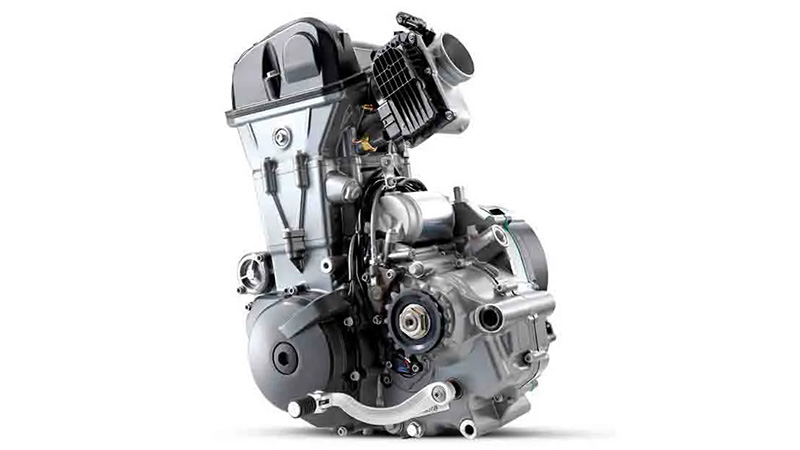
The single-cylinder engines use a single piston with simple architecture. They are cheap to produce and has less maintenance cost. The setup is suitable for lower capacity motors ranging from 100-200cc as with the bigger motor its unbalanced system develops a lot of vibration. The commuter motorcycles like the Bajaj Discover 125 bike, Suzuki Gixxer and the Honda CBR Hornet 160R comes packed with such engines. Other than this, the performance motorcycles such as motocross bikes or rally bikes also feature single-cylinder engines. It would be interesting to know that the KTM 690 Duke is the world’s most powerful single-cylinder bike. On the chassis mostly the single cylinder engine unit placed sloping forward at a 90-degree angle in other cases it could be found mounted sloping forward (i.e the BMW G 310 series).
Parallel-twin:
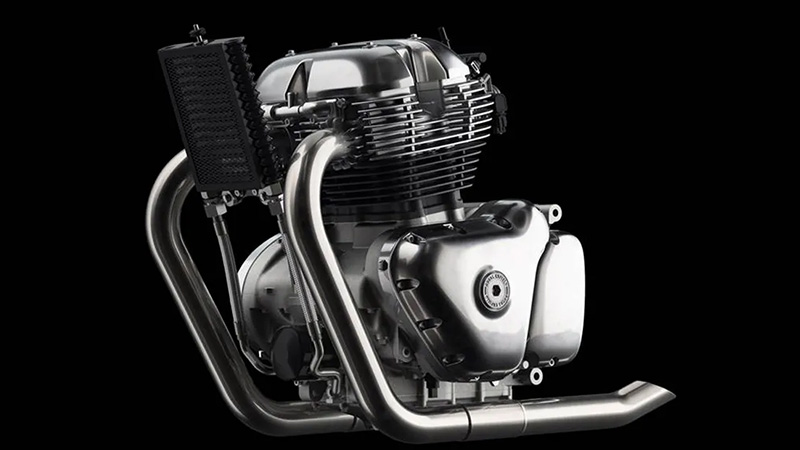
Parallel twin engines are also known as an inline-twin engine due to an extra cylinder at their disposal. The factor which differentiates parallel twin engines from the single-cylinder ones is the availability of two cylinders positioned parallel to each other in a single cylinder block. This engine layout majorly seen on the entry-level sports bikes likewise the Yamaha R3 and Kawasaki Ninja 300 bike. However, a few bikes with bigger displacement bikes like the Triumph Thunderbird in the cruiser segment and the BMW F 850 GS, a mid-capacity adventure bike also uses this architecture. It is easy to construct and features a compact design which made its placement easier within less space. With two piston works in parallel and one cancels out the movement of the other, it is a more balanced configuration as compared to a single cylinder system. Also, it is prone to supply a linear power delivery in contrast with V-twins.
Inline-triple:
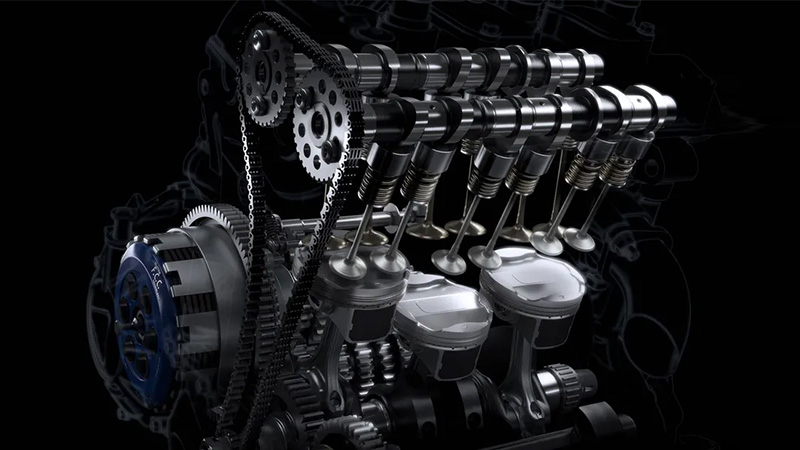
An inline-three mill is a configuration of three pistons placed parallel to each other within a cylinder block. It somewhere offers a middle ground between a V-twin and an inline-four engine. It is compact in size which makes it easier to place in the less space of a sports bike. While the power delivery is linear in nature. The configuration works in a manner that the first and third cylinder comes near the opposite end of their strokes. Also, there are vibes in the unit due to an odd number of cylinders. The Triumph Street Triple and the MV Agusta Brutale 800 bike are motorcycles which use such configuration.
Inline-four:
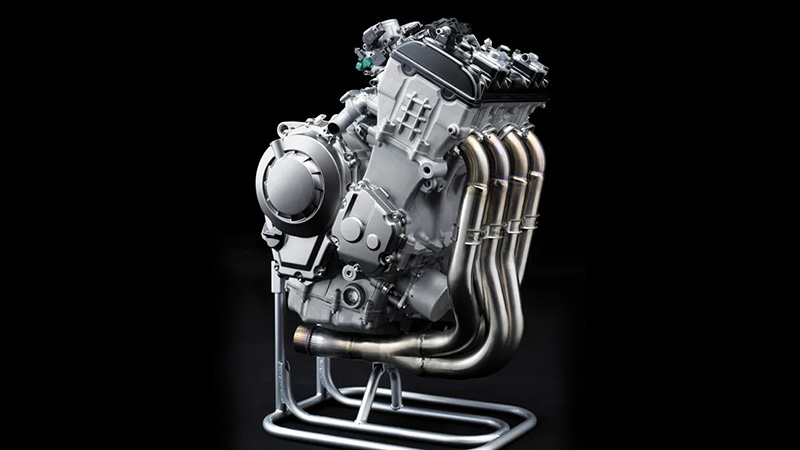
The configuration of four cylinders placed parallelly in a single cylinder block called inline-four engine. The presence of four pistons balanced out an overall movement so well that these engines are renowned as one of the smoothest running engines on a bike. Also, it allows hard engine revving without any risk of damage to any component of the engine through vibrations. The inline-four engines have the best power-to-weight characteristics as compared to others and the power delivery from this configuration is quite peaky. Almost all the sportbikes ranging from 600-1000cc uses this configuration. The Kawasaki Z900, Honda CBR1000RR bike and the Benelli 600i are some motorcycles with an inline-four engine.
Flat-twin:
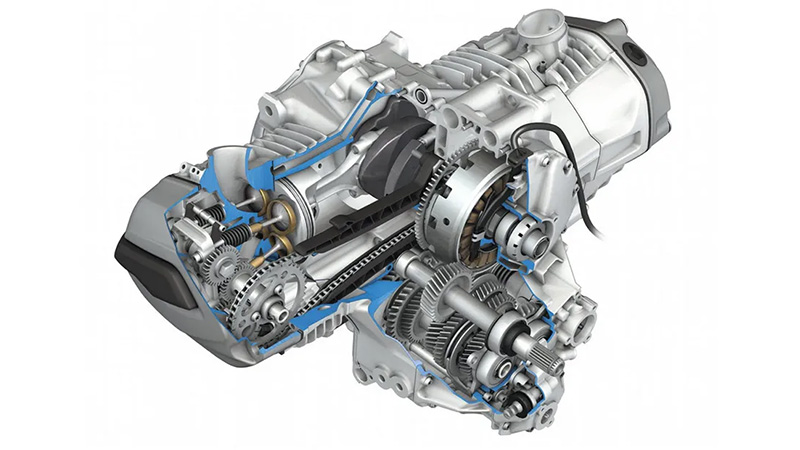
The flat twin engine has a horizontal or flat layout which is generally known as a Boxer engine. In this configuration, the two pistons are connected on the opposite sides of the crankshaft. The firing order on the flat-twin mill is the same as a 360-degree parallel twin while the movement of the piston is opposite in direction though. The flat twin is a sophisticated engine unit which requires more money for its development and maintenance as well. Here the crankshaft places in the longitudinal axis of the motorcycle. The bikes with boxer engines known to have a torque reaction wherein with the pull of throttle the bike pushed in the opposite direction of the crank rotation. However, with these engines, the motorcycle’s centre of gravity remains low and the equipped cylinders receive better air cooling on the go due to much space.
The motorcycles such as the BMW R nineT bike and GS gets boxer engines.
Flat-four & Flat-six:
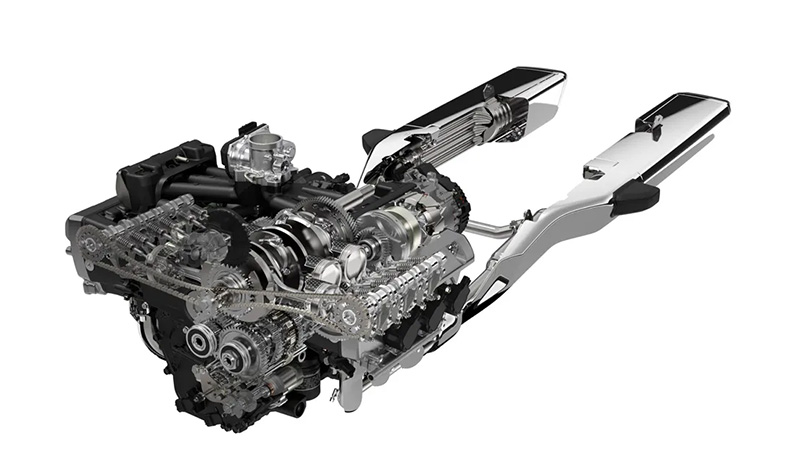
The engine layout of a flat-four or a flat six engine is same as of a boxer engine albeit they use extra cylinders. As compared to the inline-three or inline four engines they supply linear power with a perfect delivery rate. In 1975, Honda Gold Wing bike was introduced with the 1000cc flat-four engine that lately uses a bigger 1,833cc flat-six motor.
V-twin:
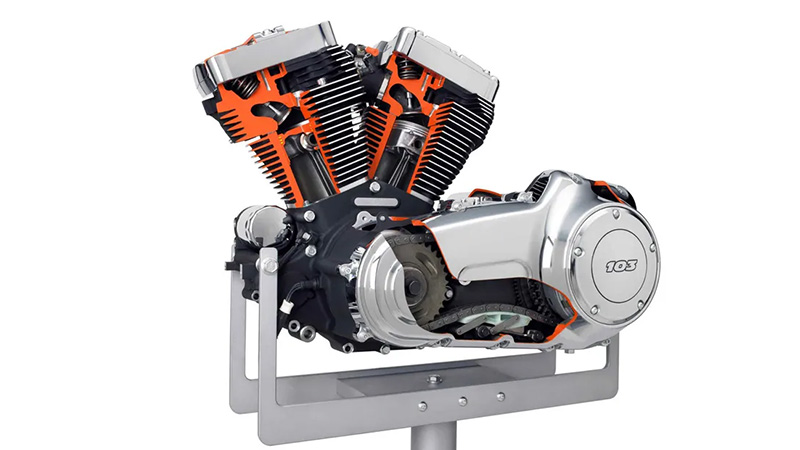
When two cylinders form a “V”, the arrangement called V-twin. Different bike makers use different angle for this configuration according to their preference. For example, Harley-Davidson motorcycles use a 45-degree V angle on almost all its motors which helps in generating better low-end torque and off-beat potato-potato exhaust note. The angle configuration used via Ducati is 90-degree V angle wherein one cylinder placed almost horizontally with other nearly vertical and this configuration known as L-twin. Other than this, the crank layout also differs in the V-twins. A number of V-twins used transverse crank layout wherein the crankshaft movement is perpendicular to the bike’s longitudinal axis. Whereas with a longitudinal crank layout the crank moves along the bike’s longitudinal axis. The firing order in the V-twin engines remains uneven which produces a burbling exhaust note. Also, these engines are known for a heavier low-end torque altogether the vibes on the bike are on a higher rate which requires balancer shafts to cancel out the developed vibration.
V-4:
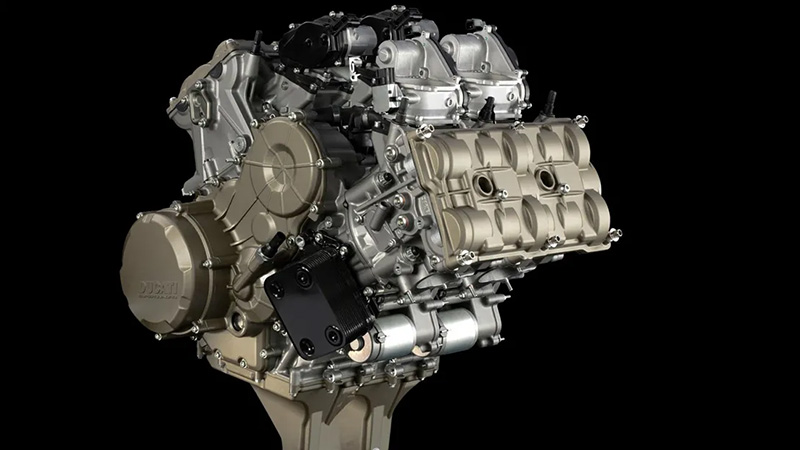
A V4 engine is a combination of two V-twins which is smooth like an inline-four mill and conveys a ton of bottom-end torque of a V-twin. It sounds like a raging bull. In terms of size, it is way more compact than a transverse inline-four, which can easily fit into the motorcycle frame. The V-4 configuration uses two sets of a cylinder with two intake and exhaust systems, cylinder head etc. which clearly means double manufacturing expense. The models such as the 2019 Aprilia RSV4 1100 Factory and the Ducati Panigale V4 bike comes packed with such engines.
Motorcycle Engine Types with Configuration & Layouts
AutomobilesBikes Reviews and TipsIndian two-wheeler market which has the majority of audience belonging to the middle-class category remained focused to offer budget offering until a decade ago. It made automakers to spawn out motorcycles majorly with small capacity single-cylinder engines. However, the emergence of prominent names in the biking industry like Kawasaki, Triumph, BMW and Suzuki, not only helped in the expansion of market but also made possible the availability of performance-oriented motorcycles with multiple cylinders. These motorcycles feature different category of engines from parallel twins to massive flat albeit their configuration and layouts are sophisticated meant for motorheads only. Still, the explanation of engines here would help you to understand different types of engines with their merits and demerits and more. Let’s start with the most affordable single-cylinder engine.
Single-cylinder:

The single-cylinder engines use a single piston with simple architecture. They are cheap to produce and has less maintenance cost. The setup is suitable for lower capacity motors ranging from 100-200cc as with the bigger motor its unbalanced system develops a lot of vibration. The commuter motorcycles like the Bajaj Discover 125 bike, Suzuki Gixxer and the Honda CBR Hornet 160R comes packed with such engines. Other than this, the performance motorcycles such as motocross bikes or rally bikes also feature single-cylinder engines. It would be interesting to know that the KTM 690 Duke is the world’s most powerful single-cylinder bike. On the chassis mostly the single cylinder engine unit placed sloping forward at a 90-degree angle in other cases it could be found mounted sloping forward (i.e the BMW G 310 series).
Parallel-twin:

Parallel twin engines are also known as an inline-twin engine due to an extra cylinder at their disposal. The factor which differentiates parallel twin engines from the single-cylinder ones is the availability of two cylinders positioned parallel to each other in a single cylinder block. This engine layout majorly seen on the entry-level sports bikes likewise the Yamaha R3 and Kawasaki Ninja 300 bike. However, a few bikes with bigger displacement bikes like the Triumph Thunderbird in the cruiser segment and the BMW F 850 GS, a mid-capacity adventure bike also uses this architecture. It is easy to construct and features a compact design which made its placement easier within less space. With two piston works in parallel and one cancels out the movement of the other, it is a more balanced configuration as compared to a single cylinder system. Also, it is prone to supply a linear power delivery in contrast with V-twins.
Inline-triple:

An inline-three mill is a configuration of three pistons placed parallel to each other within a cylinder block. It somewhere offers a middle ground between a V-twin and an inline-four engine. It is compact in size which makes it easier to place in the less space of a sports bike. While the power delivery is linear in nature. The configuration works in a manner that the first and third cylinder comes near the opposite end of their strokes. Also, there are vibes in the unit due to an odd number of cylinders. The Triumph Street Triple and the MV Agusta Brutale 800 bike are motorcycles which use such configuration.
Inline-four:

The configuration of four cylinders placed parallelly in a single cylinder block called inline-four engine. The presence of four pistons balanced out an overall movement so well that these engines are renowned as one of the smoothest running engines on a bike. Also, it allows hard engine revving without any risk of damage to any component of the engine through vibrations. The inline-four engines have the best power-to-weight characteristics as compared to others and the power delivery from this configuration is quite peaky. Almost all the sportbikes ranging from 600-1000cc uses this configuration. The Kawasaki Z900, Honda CBR1000RR bike and the Benelli 600i are some motorcycles with an inline-four engine.
Flat-twin:

The flat twin engine has a horizontal or flat layout which is generally known as a Boxer engine. In this configuration, the two pistons are connected on the opposite sides of the crankshaft. The firing order on the flat-twin mill is the same as a 360-degree parallel twin while the movement of the piston is opposite in direction though. The flat twin is a sophisticated engine unit which requires more money for its development and maintenance as well. Here the crankshaft places in the longitudinal axis of the motorcycle. The bikes with boxer engines known to have a torque reaction wherein with the pull of throttle the bike pushed in the opposite direction of the crank rotation. However, with these engines, the motorcycle’s centre of gravity remains low and the equipped cylinders receive better air cooling on the go due to much space.
The motorcycles such as the BMW R nineT bike and GS gets boxer engines.
Flat-four & Flat-six:

The engine layout of a flat-four or a flat six engine is same as of a boxer engine albeit they use extra cylinders. As compared to the inline-three or inline four engines they supply linear power with a perfect delivery rate. In 1975, Honda Gold Wing bike was introduced with the 1000cc flat-four engine that lately uses a bigger 1,833cc flat-six motor.
V-twin:

When two cylinders form a “V”, the arrangement called V-twin. Different bike makers use different angle for this configuration according to their preference. For example, Harley-Davidson motorcycles use a 45-degree V angle on almost all its motors which helps in generating better low-end torque and off-beat potato-potato exhaust note. The angle configuration used via Ducati is 90-degree V angle wherein one cylinder placed almost horizontally with other nearly vertical and this configuration known as L-twin. Other than this, the crank layout also differs in the V-twins. A number of V-twins used transverse crank layout wherein the crankshaft movement is perpendicular to the bike’s longitudinal axis. Whereas with a longitudinal crank layout the crank moves along the bike’s longitudinal axis. The firing order in the V-twin engines remains uneven which produces a burbling exhaust note. Also, these engines are known for a heavier low-end torque altogether the vibes on the bike are on a higher rate which requires balancer shafts to cancel out the developed vibration.
V-4:

A V4 engine is a combination of two V-twins which is smooth like an inline-four mill and conveys a ton of bottom-end torque of a V-twin. It sounds like a raging bull. In terms of size, it is way more compact than a transverse inline-four, which can easily fit into the motorcycle frame. The V-4 configuration uses two sets of a cylinder with two intake and exhaust systems, cylinder head etc. which clearly means double manufacturing expense. The models such as the 2019 Aprilia RSV4 1100 Factory and the Ducati Panigale V4 bike comes packed with such engines.

Leave a Reply